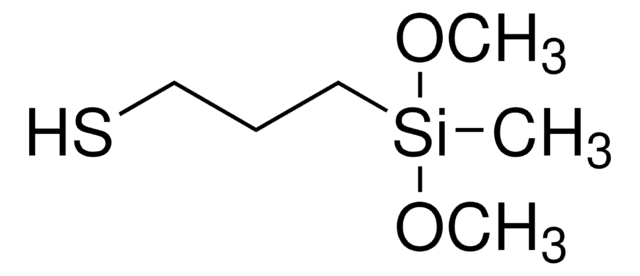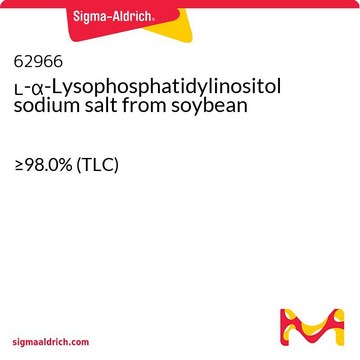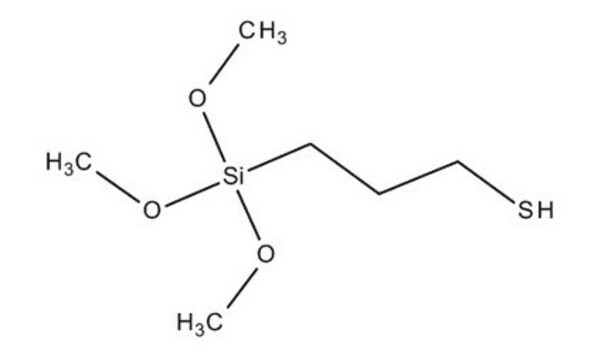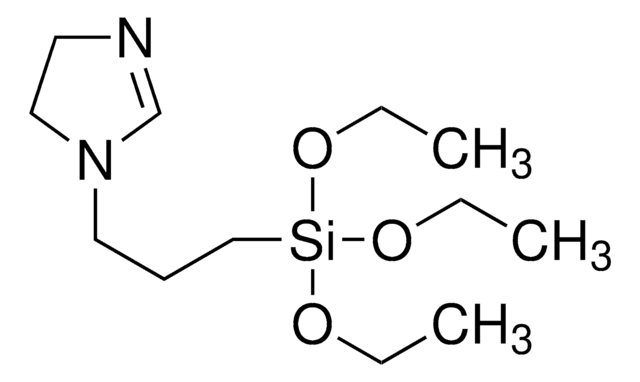Wszystkie zdjęcia(1)
Kluczowe dokumenty
63797
(3-Mercaptopropyl)triethoxysilane
≥80% (GC), technical
Synonim(y):
3-Triethoxysilyl-1-propanethiol
Zaloguj sięWyświetlanie cen organizacyjnych i kontraktowych
About This Item
Wzór liniowy:
HS(CH2)3Si(OCH2CH3)3
Numer CAS:
Masa cząsteczkowa:
238.42
Beilstein:
2039575
Numer WE:
Numer MDL:
Kod UNSPSC:
12352103
Identyfikator substancji w PubChem:
NACRES:
NA.22
Polecane produkty
klasa czystości
technical
Poziom jakości
Próba
≥80% (GC)
gęstość
0.987 g/mL at 20 °C (lit.)
grupa funkcyjna
thiol
temp. przechowywania
2-8°C
ciąg SMILES
CCO[Si](CCCS)(OCC)OCC
InChI
1S/C9H22O3SSi/c1-4-10-14(11-5-2,12-6-3)9-7-8-13/h13H,4-9H2,1-3H3
Klucz InChI
DCQBZYNUSLHVJC-UHFFFAOYSA-N
Powiązane kategorie
Opis ogólny
3-mercaptopropyl trimethoxysilane (MPTMS) is commonly used in surface modification of silica nanoparticles by creating thiol group on the surface.
Zastosowanie
(3-Mercaptopropyl)triethoxysilane (MPTS) can be used as a reagent to prepare thiol functionalized materials. Silica, SBA-15, alumina, starch, and graphene can be functionalized with MPTS and used in various applications.
MPTS functionalized SBA-15 probe is used to determine dissolved mercury in solution.
MPTS functionalized SBA-15 probe is used to determine dissolved mercury in solution.
Ta strona może zawierać tekst przetłumaczony maszynowo.
Zwroty wskazujące rodzaj zagrożenia
Zwroty wskazujące środki ostrożności
Klasyfikacja zagrożeń
Aquatic Chronic 2
Kod klasy składowania
10 - Combustible liquids
Klasa zagrożenia wodnego (WGK)
WGK 3
Temperatura zapłonu (°F)
190.4 °F - closed cup
Temperatura zapłonu (°C)
88 °C - closed cup
Środki ochrony indywidualnej
Eyeshields, Gloves, type ABEK (EN14387) respirator filter
Wybierz jedną z najnowszych wersji:
Masz już ten produkt?
Dokumenty związane z niedawno zakupionymi produktami zostały zamieszczone w Bibliotece dokumentów.
Klienci oglądali również te produkty
Greg J Nusz et al.
ACS nano, 3(4), 795-806 (2009-03-20)
We present the development of an analytical model that can be used for the rational design of a biosensor based on shifts in the local surface plasmon resonance (LSPR) of individual gold nanoparticles. The model relates the peak wavelength of
Tuo Gao et al.
Sensors (Basel, Switzerland), 19(11) (2019-06-07)
Nanoparticle based chemical sensor arrays with four types of organo-functionalized gold nanoparticles (AuNPs) were introduced to classify 35 different teas, including black teas, green teas, and herbal teas. Integrated sensor arrays were made using microfabrication methods including photolithography and lift-off
Preparation of colloidal gold multilayers with 3-(mercaptopropyl)-trimethoxysilane as a linker molecule
Tseng J-Y, et al.
Colloids and Surfaces. A, Physicochemical and Engineering Aspects, 182(1-3), 239-245 (2001)
Ning Gan et al.
International journal of nanomedicine, 6, 3259-3269 (2012-01-10)
The purpose of this study was to devise a novel electrochemical immunosensor for ultrasensitive detection of alfa-fetoprotein based on Fe(3)O(4)/Au nanoparticles as a carrier using a multienzyme amplification strategy. Greatly enhanced sensitivity was achieved using bioconjugates containing horseradish peroxidase (HRP)
Guobin Shan et al.
Theranostics, 3(4), 267-274 (2013-04-23)
Nanotechnology approaches offer the potential for creating new optical imaging agents with unique properties that enable uses such as combined molecular imaging and photo-thermal therapy. Ideal preparations should fluoresce in the near-infrared (NIR) region to ensure maximal tissue penetration depth
Global Trade Item Number
| SKU | GTIN |
|---|---|
| 63797-100ML-F | 4061838254115 |
| 63797-25ML-F | 4061832726182 |
Nasz zespół naukowców ma doświadczenie we wszystkich obszarach badań, w tym w naukach przyrodniczych, materiałoznawstwie, syntezie chemicznej, chromatografii, analityce i wielu innych dziedzinach.
Skontaktuj się z zespołem ds. pomocy technicznej




![Bis[3-(triethoxysilyl)propyl] tetrasulfide technical, ≥90% (NMR)](/deepweb/assets/sigmaaldrich/product/structures/242/790/625f5cba-32bd-4acf-a3be-e119e9cf844f/640/625f5cba-32bd-4acf-a3be-e119e9cf844f.png)










![N-[3-(trimetoksysililo)propylo]etylenodiamina 97%](/deepweb/assets/sigmaaldrich/product/structures/149/508/f87a9a89-f138-4c5e-9fe0-6561914241c3/640/f87a9a89-f138-4c5e-9fe0-6561914241c3.png)
